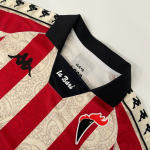
Will the collar return to the forefront of adidas jerseys next season?
One of the elements of the shirt that went from being indispensable to being totally forgotten
April 6th, 2022
In the last fifteen years, the collar has gone from being one of the indispensable elements in the design of a football uniform to a veritable chimera on pitches all over the world. Since Eric Cantona's raised collar and the baggy uniforms of the 90s, times have changed: few of the uniforms presented to date have a collar, and among the most emblazoned clubs in Italy and England only a few have sported a timid lapel. The only exception is Atalanta, who have included it in all three shirts.
From next season, the collar will be present in almost all the first leaks of the shirts of the clubs sponsored by adidas. From Arsenal to Manchester United, the three stripes have decided to reopen their archives to dig up an element that has made the uniforms, particularly the English ones, iconic and inimitable. The collar is the element that immediately transports the football jersey out of football into a sartorial dimension, elegant and suitable for special editions for fans and enthusiasts, such as the latest jersey made with the collar and the iconic little man stripes by LC23 and Kappa for Bari.


Although it was always appreciated by fans and players, the anti-collar revolution came in the early 2000s, when new materials were introduced into the production of jerseys. The focus of the brands shifted towards the horizon of practicality, with jerseys that prioritised the comfort and performance of the athletes. Lightweight and stretchy fabrics became the quality standard, making jerseys close-fitting and consequently more suitable for collarless shirts. Among the most bizarre consequences of this new paradigm was the desire to emphasise restraint through the stretch fabric of the shirts. The first team to adopt this type of shirt was Roma in 2004-05, with uniforms produced by Diadora.
This has not changed over time and today, in order to make the jersey lighter and more dynamic, brands still tend to eliminate it. Another example concerns the Italy jersey, the one produced by PUMA immediately after winning the European Championships with ULTRAWEAVE technology, an extremely light fabric with a base frame of only 72 grams, obviously without the collar. This is a further sign of how football shirts are now increasingly divided between technical performance garments and shirts that can also be worn off the pitch, and the collar is a rather reliable flag for understanding which way the wind is blowing.
It is therefore possible that the choice of adidas to bring back this excess of fabric in its templates for next season, breaking the unwritten rule of performance, could also be interpreted with the intention of positioning itself more on the market of collectors and fashionistas than on that of sportsmen. We are in fact experiencing a rediscovery of the football shirt as a fashion item and what better time to relaunch a cut that ideally links the two worlds. Lovers of 90s fashion and collars can rest assured that it won't be long before they see a Manchester United shirt to be starched, even if Cantona will no longer be proudly wearing it.












